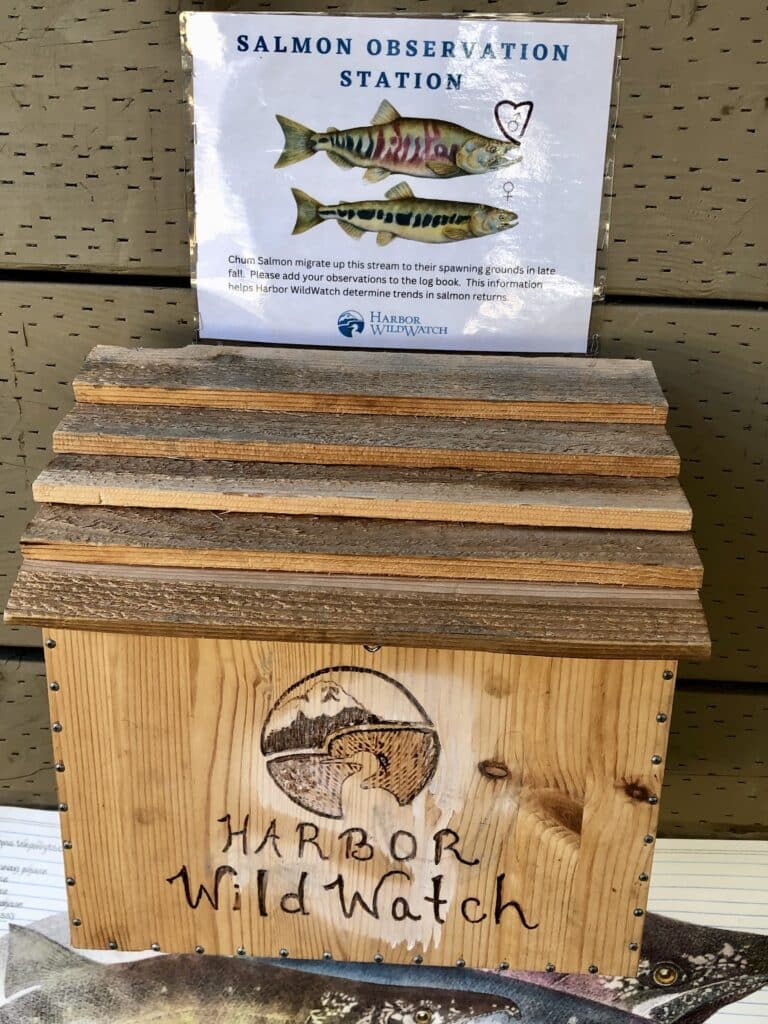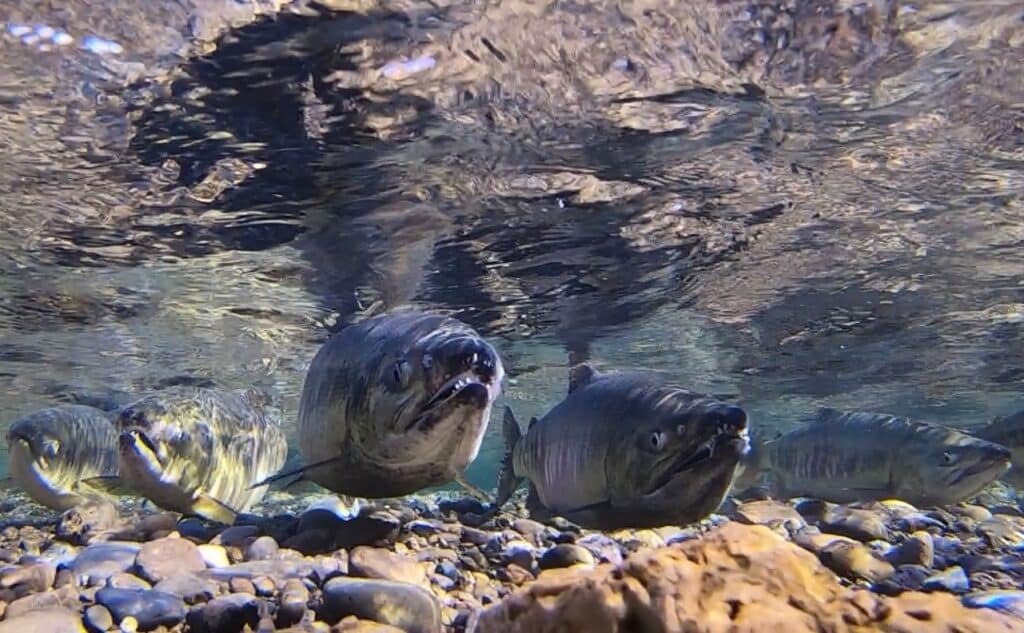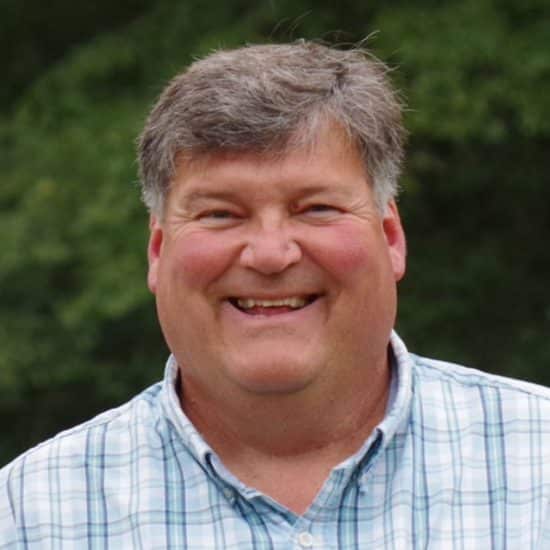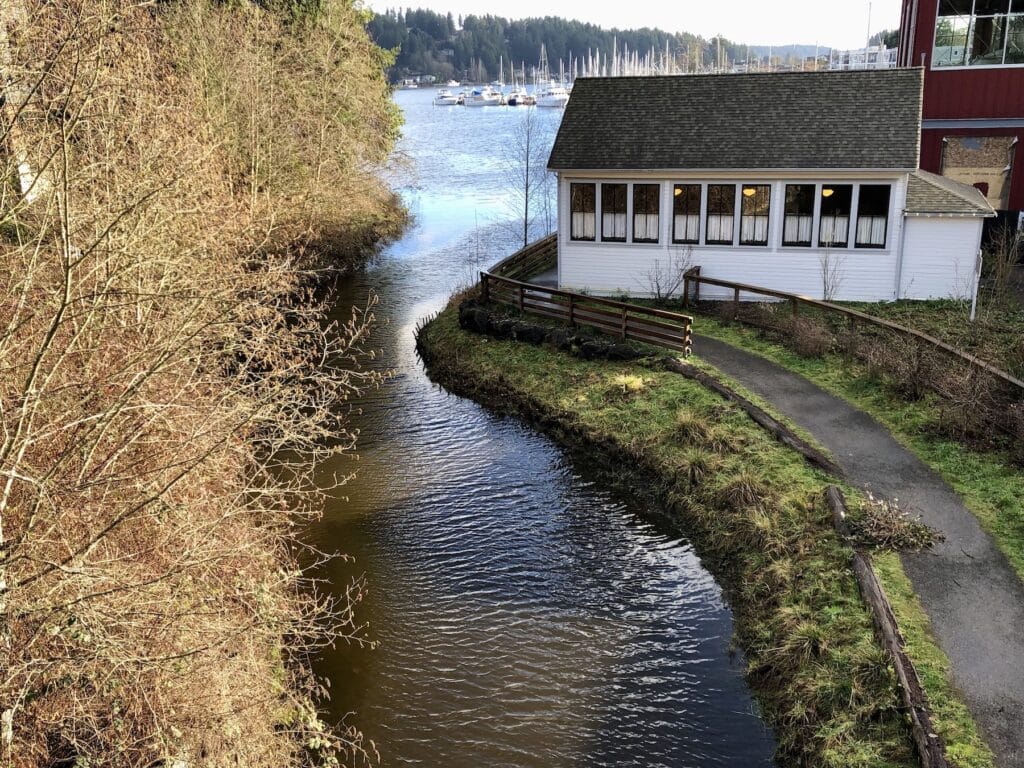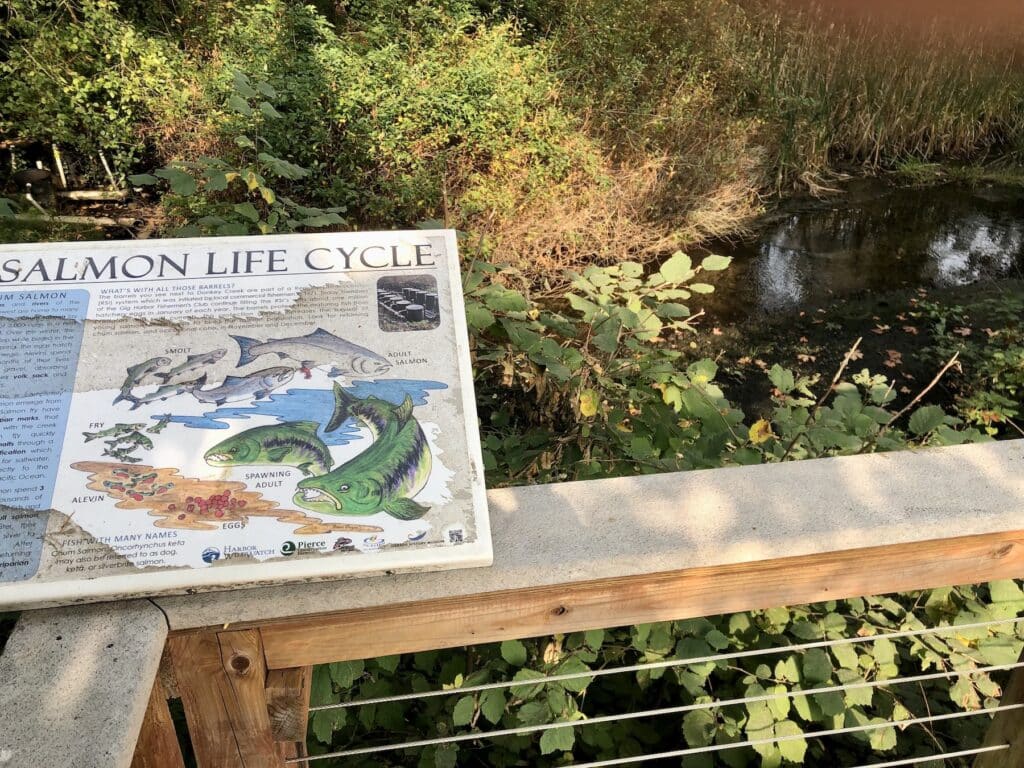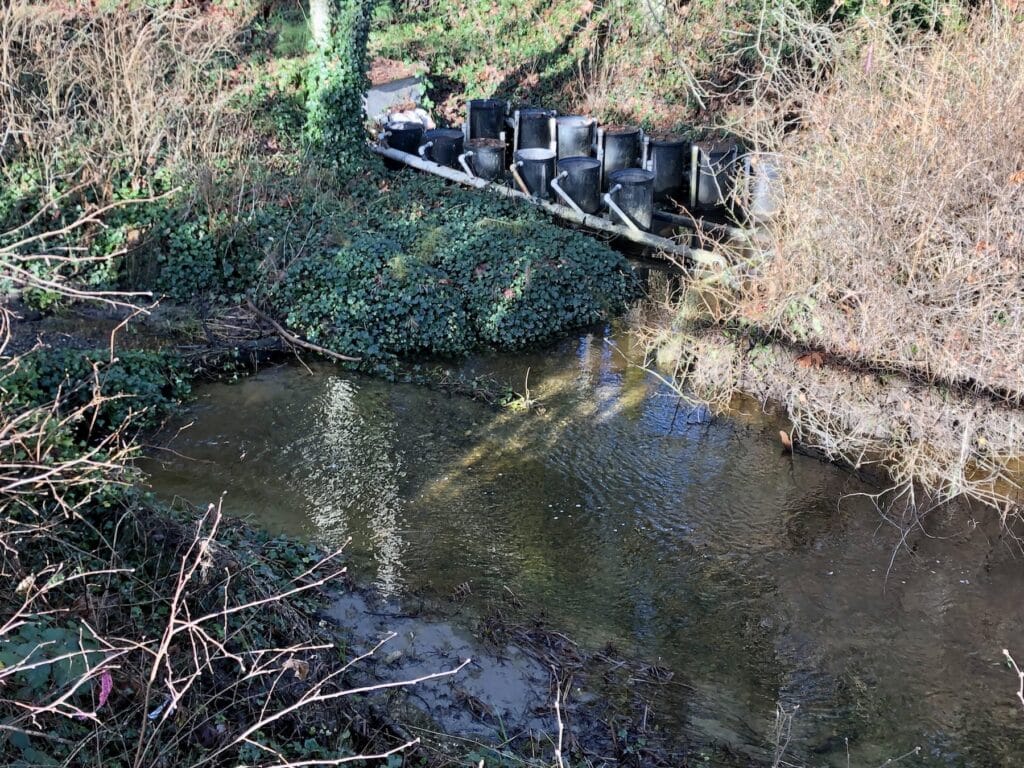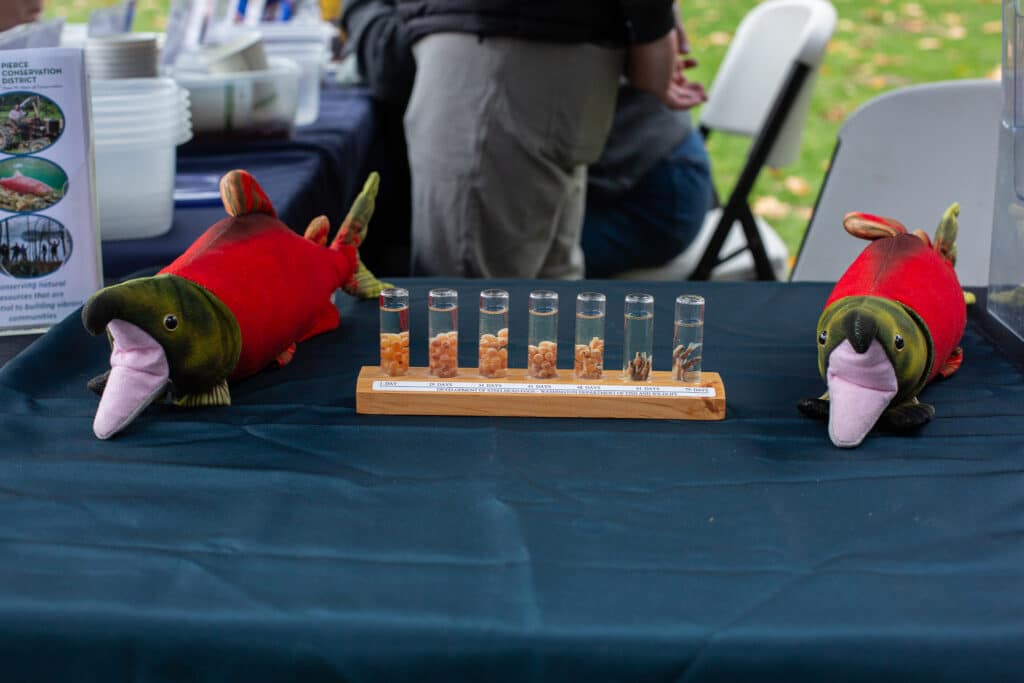Community Environment
Idle incubator largely responsible for absent chum run
The guests of honor failed to show for November’s annual chum salmon festival at Donkey Creek Park.
Harbor WildWatch keeps a ledger along the stream bank for viewers to document their sightings. None were recorded.
“No fish were seen in Donkey Creek with the exception of one tail that Stena saw early in the season,” the nonprofit group’s education director, Rachel Easton, said of science director Stena Troyer.
Matt Bogaard, chum salmon species specialist with the state Department of Fish and Wildlife, said agency records show a 10-year average of just over 300 fish returning to the creek.
Salmon face many challenges that could contribute to their absence last fall. Among them are ocean conditions, fishing, marine mammals, culverts, gully washers, sediment, starvation and disease. North Creek, as it’s also called, has also been found by the state to contain high levels of lead and PCBs. These obstacles, however, would likely produce a more gradual decline. What could make the chum just up and disappear?
Incubating since 1970
On top of the list is the inability to obtain eggs for a remote site incubator. Gig Harbor Commercial Fishermen’s Civic Club has been hatching, growing and releasing chum at the mini-hatchery since 1970. They receive 1 million eggs per year from the state’s Minter Creek Fish Hatchery.
There have been gaps, however. When Fish and Wildlife detects the virus infectious haematopoietic necrosis in salmon, it withholds eggs. Originally, they were denied for one year. Now it’s three.
The virus prevented the fishermen’s group from operating the remote site incubator in 2017, 2018 and 2019. The ensuing two years were lost to the Covid pandemic.
It did conduct a successful plant in 2022, said group leader Tom Lovrovich. Most chum salmon migrate to the ocean and return to spawn where they were born four years later. Simple math dictates that 2021 through 2025 would be down years.
Few wild salmon
North Creek has never sustained much of a natural chum run on its own. It’s less than 2 miles long, with a driveway blocking access to the upper reaches. Stormwater runoff, worsened by recent development, increases stream velocity and deposits silt that can smother eggs. The lower, tidal stretch lacks logs and rocks where fish can rest and hide.
Lovrovich, 60, calls it a glorified drainage ditch.
“There were no chum present in the creek when they started the program,” Lovrovich said of the fishermen’s club. “The stream is not good for natural-spawning salmon. If you were to take away the hatchery altogether, there would be zero fish, like this fall.”
The city did buy 52 forested acres through which North Creek flows that it will keep in conservation. The undisturbed habitat provides fish with shade and seclusion.
Poor natural spawning plus no hatchery help is a formula for poor returns.
“Obviously this year with not one fish coming back tells you the creek doesn’t have natural spawning success,” said Lovrovich, who has been volunteering at the incubator since he was 11 years old. “Why were there no fish there this fall? It’s a very simple answer. The reason there were no fish this year is because the hatchery didn’t operate that parent year. When nothing is going out, nothing is coming back. If that hatchery intervention goes away, what you saw this year you’ll see forever. The chance of seeing fish in the future will be minimal.”
Bogaard of Fish and Wildlife said records show only 13 returning chum were counted during the 2023 parent year of 2019. It takes two to tango, so no more than six mated. If any were born, they’d still face four years of obstacles to make it back to North Creek.
Virus detected again
More bad news arrived last week.
“This year we had a (virus) detection in our chum, so we’re not able to send out any co-op eggs this year,” said Minter Creek Hatchery Manager Ben Lowery.
The hatchery is taking measures that might allow it to skip just one year instead of three.
“We have the intent to provide eggs for the next two years,” Lowery said. There are steps we can take. Our goal is to get eggs out next season.”
Minter Creek’s chum return of 16,000 fell short of the 10-year average of 22,000, but it was robust enough for the hatchery to achieve its goals. It endeavors to raise and release 2 million chum on site and provide 1.5 million eggs to remote incubation sites such as Donkey Creek’s. It also seeks to allow 10,000 fish to continue upstream for natural spawning. Eight thousand bypassed the hatchery last season, Lovrovich said.
When the virus prevents the hatchery from dispensing 1.5 million eggs to groups, they’re reared on site and released into Minter Creek. They’re not wasted, but return there instead of to places like North Creek.
Same result in Meyer Creek
A scenario similar to North Creek played out at Rosedale’s Meyer Creek. Years ago, Lovrovich set up a couple incubators there that were also fed by Minter Creek eggs. Chum filled the stream each November. Since they were shut down about 10 years ago, only 15 to 25 naturally spawned fish trickle in annually, said Jim Langhelm, who tended the operation. A fair number arrived last year, but many were devoured by sea lions in the lagoon, he said.
“I don’t know when the last time Tom had eggs in there,” Langhelm said of the North Creek incubator. “That run, like Meyer Creek here, is predominately dependent on incubator eggs rather than a self-sustaining spawn.”
Crescent, Purdy and McCormick creeks also had remote site incubators.
Generally, at least some fish make it back even in years not aided by hatchery eggs. Other factors likely contributed to last fall’s goose egg.
Warm ocean temperatures are a major culprit that can drive chum to migrate farther than usual, forcing them to expend more energy and messing with their ability to get back, said Harbor WildWatch’s Easton, who saw several harbor seals and a few river otters patrolling the creek mouth.
“There’s also been a ton of sediment and sand washed into the creek from the construction and the roundabout installation,” she said. “For these poor fish, it’s death by a thousand cuts, unfortunately.”
Culvert is or isn’t a problem
A culvert that conveys North Creek under Harborview Drive blocks two-thirds of the fish, according to Fish and Wildlife. They must swim through a 6-foot by 6-foot concrete box. A drop-off and stream velocity create a complete barrier to juvenile fish and partial barrier to adult salmon, the agency says.
The city has budgeted funds for design and permitting to replace the culvert with a bridge, and applied for a construction grant, according to its website.
Lovrovich said it’s not an obstruction.
“For decades, fish have gone through that culvert with ease,” he said. “All salmon know when a freshet (rush of stream water from heavy rain along with high tides) comes. They know it and go.”
Poor South Sound return
Early reports show a below-average chum return throughout Puget Sound, particularly Central and South Sound, said Fish and Wildlife’s Bogaard. Some fish return after three or five years instead of four, which could help restore runs, along with fish straying into new streams. Positive ocean conditions the past few years could help, as well as fish passage and restoration projects, he said.
Jon Oleyar, a fish biologist with the Suquamish Tribe, concurred that the 2023 chum return was “very low,” specifically to South Sound. There was only one day of commercial fishing in the mid-Sound, and catches were extremely low.
“I’m not sure the run size ever got above 300,000 for the whole South Sound estimate, and that’s pretty low,” he said. “With no commercial fishing out front, I would have expected a few more fish into Donkey/North Creek. Several smaller streams here in the Kitsap area also had very low numbers of chum salmon return, some of the lowest I have seen in 25 years of surveying these streams.”
Most small Puget Sound creeks don’t receive many wild chum salmon. They prefer larger streams and rivers, Oleyar said.
“If a stream which doesn’t receive many wild chum to begin with also doesn’t receive any hatchery supplementation, often times the result is no fish returning,” he said.
That’s all the more reason to continue operating the North Creek hatchery program, Lovorich said.
“It’s neat to see this million-egg hatchery run by a local group have success and large returns at times,” Lovrovich said. “We could have good returns if we could get a good supply of eggs.”

